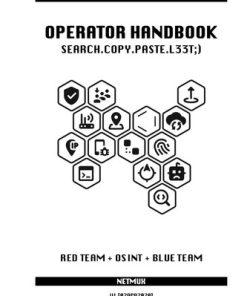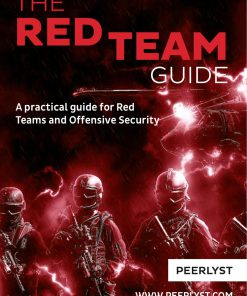Cybersecurity attack and defense strategies infrastructure security with Red team and Blue team taxtics 1st Edition by Yuri Diogenes, Erdal Ozkaya ISBN 178847385X 9781788473859
$50.00 Original price was: $50.00.$25.00Current price is: $25.00.
Cybersecurity attack and defense strategies infrastructure security with Red team and Blue team taxtics 1st Edition by Yuri Diogenes, Erdal Ozkaya – Ebook PDF Instant Download/Delivery: 178847385X, 978- 1788473859
Full download Cybersecurity attack and defense strategies infrastructure security with Red team and Blue team taxtics 1st Edition after payment

Product details:
ISBN 10: 178847385X
ISBN 13: 978-1788473859
Author: Yuri Diogenes, Erdal Ozkaya
Publisher’s Note: This is an outdated edition published in 2018. Cyberthreats and the strategies to counter them have evolved exponentially in the months since this book was first published. A new edition, updated for 2020 with the very latest in cybersecurity threats and defense strategies, is now available.
Enhance your organization’s secure posture by improving your attack and defence strategies
Key Features
- Gain a clear understanding of the attack methods, and patterns to recognize abnormal behavior within your organization with Blue Team tactics
- Learn to unique techniques to gather exploitation intelligence, identify risk and demonstrate impact with Red Team and Blue Team strategies
- A practical guide that will give you hands-on experience to mitigate risks and prevent attackers from infiltrating your system
Book Description
The book will start talking about the security posture before moving to Red Team tactics, where you will learn the basic syntax for the Windows and Linux tools that are commonly used to perform the necessary operations. You will also gain hands-on experience of using new Red Team techniques with powerful tools such as python and PowerShell, which will enable you to discover vulnerabilities in your system and how to exploit them. Moving on, you will learn how a system is usually compromised by adversaries, and how they hack user’s identity, and the various tools used by the Red Team to find vulnerabilities in a system.
In the next section, you will learn about the defense strategies followed by the Blue Team to enhance the overall security of a system. You will also learn about an in-depth strategy to ensure that there are security controls in each network layer, and how you can carry out the recovery process of a compromised system. Finally, you will learn how to create a vulnerability management strategy and the different techniques for manual log analysis.
What you will learn
- Learn the importance of having a solid foundation for your security posture
- Understand the attack strategy using cyber security kill chain
- Learn how to enhance your defense strategy by improving your security policies, hardening your network, implementing active sensors, and leveraging threat intelligence
- Learn how to perform an incident investigation
- Get an in-depth understanding of the recovery process
- Understand continuous security monitoring and how to implement a vulnerability management strategy
- Learn how to perform log analysis to identify suspicious activities
Who this book is for
This book aims at IT professional who want to venture the IT security domain. IT pentester, Security consultants, and ethical hackers will also find this course useful. Prior knowledge of penetration testing would be beneficial.
Cybersecurity attack and defense strategies infrastructure security with Red team and Blue team taxtics 1st Table of contents:
Introduction
- Who This Book is For: This book is designed for cybersecurity professionals, IT security teams, and anyone interested in understanding how to handle security threats, vulnerabilities, and incident response in real-world scenarios.
- What This Book Covers: It covers a wide range of topics, including threat landscape, incident response, privilege escalation, threat intelligence, network segmentation, and disaster recovery.
- To Get the Most Out of This Book: It’s recommended to have a basic understanding of security concepts, and familiarity with tools such as NMap, Metasploit, and SQL injection attacks can be helpful.
- Download the Color Images: This could be a reference to accompanying visual aids available online for better comprehension of diagrams and workflows.
- Conventions Used: Likely refers to formatting conventions used in the book for clarity, such as highlighting commands, tool names, or important concepts.
Core Topics
Security Posture
- The Current Threat Landscape: Discusses emerging threats and how organizations can prepare to mitigate them.
- Credentials – Authentication and Authorization: Basics of securing user credentials through authentication methods.
- Cybersecurity Challenges: Describes ongoing issues such as outdated security practices, evolving attack vectors, and inadequate responses.
- Red and Blue Teams: Explains the roles of red teams (attackers) and blue teams (defenders) in cybersecurity exercises.
Incident Response Process
- Incident Response (IR): Guides on creating and executing an incident response process, building an IR team, and optimizing post-incident activities.
- Best Practices and Real-World Scenarios: Includes real examples and lessons learned, focusing on continuous improvement of incident response protocols, especially in cloud environments.
Cybersecurity Kill Chain
- External Reconnaissance and Tools: Covers the methods and tools (e.g., NMap, Wireshark, Metasploit) attackers use for reconnaissance and scanning.
- Compromising the System: Discusses various attack vectors like phishing, SQL injection, and exploiting zero-day vulnerabilities.
- Chasing a User’s Identity: Describes strategies for hacking user credentials, such as brute force, social engineering, and pass-the-hash techniques.
Privilege Escalation & Lateral Movement
- Privilege Escalation: Outlines methods for gaining higher privileges within compromised systems, including vertical and horizontal privilege escalation.
- Lateral Movement: Discusses how attackers move within a network to expand their control, focusing on tools like PowerShell, Sysinternals, and techniques like pass-the-hash and Active Directory exploits.
Security Policies & Network Segmentation
- Security Policy: The importance of creating and enforcing security policies, educating users, and implementing whitelisting and hardening practices.
- Network Segmentation: Describes the defense-in-depth approach to securing network infrastructure through physical and virtual segmentation, remote access controls, and hybrid cloud security.
Active Sensors & Threat Intelligence
- Detection Capabilities: Covers intrusion detection and prevention systems (IDS/IPS), anomaly-based detection, and behavior analytics.
- Threat Intelligence: Explains how organizations can leverage open-source and proprietary tools for gathering and analyzing threat intelligence.
Incident Investigation & Recovery
- Investigating an Incident: Guides on scoping the incident, identifying key artifacts, and handling compromised systems in both on-premises and hybrid cloud environments.
- Recovery Process: Discusses disaster recovery planning, the creation of a recovery team, risk assessments, business impact analysis, and maintaining a comprehensive recovery plan.
Vulnerability Management
- Vulnerability Management Strategy: Explains the process of identifying, analyzing, and remediating vulnerabilities within an organization’s IT infrastructure, including the use of vulnerability management tools like Nessus and LANDesk.
- Best Practices for Vulnerability Management: Offers practical tips on conducting vulnerability assessments, tracking remediation, and ensuring compliance with internal security standards.
Log Analysis
- Log Correlation and Analysis: Teaches how to analyze logs from various systems (e.g., Windows, Linux, firewalls) to detect and investigate potential security incidents.
People also search for Cybersecurity attack and defense strategies infrastructure security with Red team and Blue team taxtics 1st :
cybersecurity attack and defense strategies third edition
cybersecurity – attack and defense strategies yuri diogenes
network attacks and defense strategies
common cybersecurity attacks and defense strategies
mitigation strategies for cyber attacks
Tags:
Yuri Diogenes,Erdal Ozkaya,Cybersecurity,attack,defense,strategies,infrastructure,security,Red team,Blue team,taxtics 1st
You may also like…
Computers - Security
Computers - Computer Science
Operator Handbook: Red Team + OSINT + Blue Team Reference 1st Edition Joshua Picolet
Computers - Security
Computers - Security
Romance - Military Romance
Computers - Computer Science
Operator Handbook Red Team OSINT Blue Team Reference Joshua Picolet Netmux
Computers - Security
Uncategorized
Tru Guardian Group Security Team Book 1 1st Edition by Bree Livingston, Christina Schrunk B08VFG3TBJ
Computers - Internet & World Wide Web












